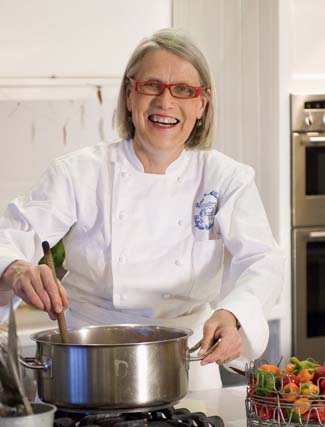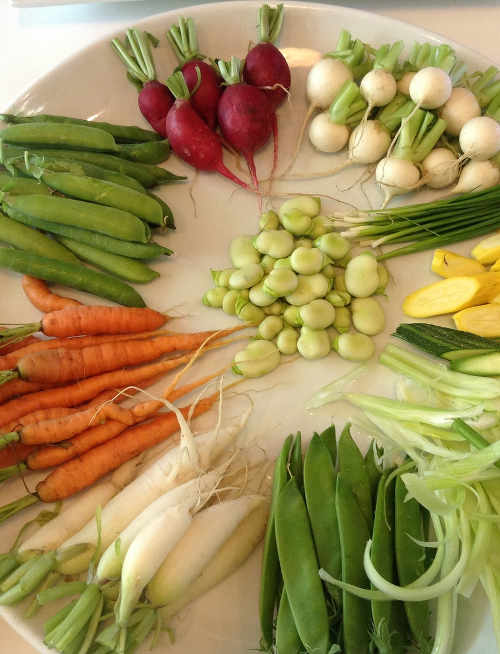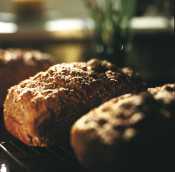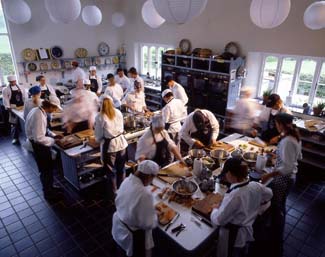The Darina Allen Column
 This month Darina talks about an important topic that's on every parent's mind at the beginning of a new school year - school lunches
This month Darina talks about an important topic that's on every parent's mind at the beginning of a new school year - school lunches
When I was a child my brothers, sisters and I ran home up the hill from the village school in Cullohill every day for lunch. How lucky were we?
I didn’t even think about it at the time but now with hindsight I realise how fortunate we were to have a nourishing meal at midday. Mummy didn’t have the daily hassle that mothers all over the country have of trying to provide school lunches that their children will actually tuck into and eat.
Mums who feel strongly about the importance of simple healthy food have the added challenge of the children’s fear of their friend’s jeers and snide remarks when they spy something which they perceive to be odd or peculiar in a lunchbox. A daily reality for many kids and a form of bullying which can cause distress and anxiety.
Few young children have the confidence to be different and many parents quickly succumb to the sliced pan sandwich rather than risk their little dotes being taunted and upset. Parent/teacher groups can be enormously influential in this area.
Teachers of whom so much is asked already can really help by explaining to pupils that passing derogatory remarks about a friend's school lunch is simply not an option. But being curious about the content can be a learning experience. Many schools are now multi ethnic, so what delicious but unfamiliar food does my Nigerian, Lithuanian, Croatian, Polish.....friend enjoy for lunch?
What’s it called? How do beans, lentils and avocados grow? What’s a spice? A chilli....?
One friend told me that her daughter’s friends laughed even if she had a raw carrot or one of the delicious home-grown tomatoes from her Dad's tunnel.
This is an urgent on-going problem for parents and teachers to work together to find a solution – as ever not easy. There’s also the ever increasing challenge of food allergies and intolerances. So I include some recipes from the Hemsley Hemsley sister cookbook which my grandchildren have been enjoying.
Good bread is vital and for many people impossible to buy and I don’t use that word lightly unless you make your own or have access to a natural sourdough bread or a stoneground wholemeal bread. Fortunately more craft bakeries are emerging and it’s easy to make your own soda or brown yeast bread but it all takes time....a scarce commodity
So here are some of the ideas I got from a quick poll of my grandchildren and their friends. A flask of soup is good particularly in autumn and winter; one loved brothy soup with lots of bits in it, little salads with a base of rice, lentils, quinoa with chickpeas and beans, little dice of avocado, cucumber, tomatoes, cheese, apple, tossed in a vinaigrette, (make enough dressing to last for the week).
Little bits of cold chicken and ham or bacon are great to keep in a box in the fridge to add to a sandwich filling or sprinkle on top of salads. One of my grandchildren loves slices of salami or chorizo that can be picked up and nibbled easily or added to a sandwich.
Chopped fruit tossed in lemon juice and honey was also a daily favourite, hummus and raw carrot dippers or strips of pitta. Homemade potato crisps, or tortilla chips or oatcakes or rye crackers were also popular. Several others loved smoothies and or homemade milk drinks. For example milk, vanilla and maple syrup is India’s current favourite.
If you have a Nutribullet (which certainly costs a few bob, but everyone I spoke to raves about it and says it is so worth the money), nutritious drinks which are almost meals in themselves can be made in seconds which include all kinds of fresh vegetables, fruit and good things.
I include some recipes from sisters Jasmine and Melissa Hemsley’s cookbook Hemsley Hemsley The Art of Eating Well (Easons €17.99; available online http://www.easons.com/p-3057464-the-art-of-eating-well) which my grandchildren have been enjoying, they also have the bonus of being gluten free.
RECIPES: Crudités with Penny’s Sweet and Sour Dip
 Crudités are a perfect first course for Winter or Summer, but to be really delicious one must choose very crisp and fresh vegetables. Cut the vegetables into bite-sized bits so they can be picked up easily. You don’t need knives and forks because they are usually eaten with fingers.
Crudités are a perfect first course for Winter or Summer, but to be really delicious one must choose very crisp and fresh vegetables. Cut the vegetables into bite-sized bits so they can be picked up easily. You don’t need knives and forks because they are usually eaten with fingers.
Use as many of the following vegetables as are in season:
tomatoes quartered, or left whole with the calyx on if they are freshly picked
purple sprouting broccoli, broken (not cut) into florets
calabrese (green sprouting broccoli), broken into florets
cauliflower, broken into florets
French beans or mange tout
baby carrots, or larger carrots cut into sticks 5cm/2 inches long, approx.
cucumber, cut into sticks 5cm/2 inches long approx.
tiny spring onions, trimmed
red cabbage, cut into strips
celery, cut into sticks 5cm/2 inches long approx.
chicory, in leaves
red, green or yellow pepper, cut into strips 5 cm/2 inches long approx., seeds removed
very fresh Brussels sprouts, cut into halves or quarters
whole radishes, with green tops left on
parsley, finely chopped
thyme, finely chopped
chives, finely chopped
sprigs of watercress
A typical plate of Crudités might include the following: 4 sticks of carrot, 2 or 3 sticks of red and green pepper, 2 or 3 sticks of celery, 2 or 3 sticks of cucumber, 1 whole radish with a little green leaf left on, 1 tiny tomato or 2 quarters, 1 Brussels sprout cut in quarters, and a little pile of chopped fresh herbs.
Wash and prepare the vegetables. Arrange on individual white side plates in contrasting colours, with a little bowl of aioli in the centre. Alternatively, do a large dish or basket for the centre of the table. Arrange little heaps of each vegetable in contrasting colours.
Put a bowl of Penny’s Sweet and Sour Dip in the centre and then guests can help themselves.
Note: All vegetables must be raw.
Penny’s Sweet and Sour Dip
4 tablespoons Soy Sauce
4 tablespoons Local Raw Honey
4 tablespoons Rice Wine Vinegar
Place all the above ingredients in a clean jam jar, put the lid on and shake to mix. Pour into a small serving bowl.
Paradise Bars
‘Guilt-free’ snacks from’ Hemsley and Hemsley - and they’re not just for kids who need an energy boost. “If we find ourselves stuck somewhere and hungry, these bars do the job without sending our blood sugar levels flying sky high,” the London-based sisters say.
Makes 24 bars
200g/7oz bar of creamed coconut
6 tablespoons coconut oil
3 tablespoons raw honey
1½ teaspoons vanilla extract
A pinch of sea salt
150g/5oz desiccated coconut
200g/7oz (85% cocoa solids) dark chocolate
Line a 20cm square tin with baking parchment. In cold weather, place the unopened packet of creamed coconut in a bowl of warm water to melt it through. In warm weather, the creamed coconut will already be fluid.
When it’s soft all the way through, pour into a bowl and mix in the coconut oil (it will melt if it’s hard), raw honey, vanilla, salt and 2-4 tablespoons water if you like a soften centre.
Stir in the desiccated coconut evenly to create a dough consistency.
Pour the dough into the prepared tin. Press the mixture down with the back of a spoon to make it level and set in the fridge for 15 minutes until hard.
Turn the tin of coconut mixture out onto a chopping board and slice into 6 horizontal slices by 4 vertical. Place them onto a baking tray lined with baking parchment and keep in the freezer while you prep the chocolate.
Melt the chocolate in a glass or metal bowl over a pan of warm water – make sure the water does not touch the bottom of the bowl and do not allow the water to boil or simmer – you may have to keep removing from the heat. This should take about 30 minutes.
When the chocolate has almost melted, take the bowl off the heat and place on a tea towel to avoid slipping. Leave it to cool as much as possible without it hardening to give a thicker coating to the paradise bars – stir occasionally.
Dip the frozen coconuts bars into the chocolate using two forks, letting the excess drop off, and carefully place back onto the cold baking tray, leaving space between each bar. If the chocolate mixture becomes too cold, you may need to put it back over the simmering water again.
When you’ve finished dipping all the bars, place the tray in the fridge until set. Once set, seal in a glass or ceramic container in the fridge or freezer until required. If they are kept sealed in the fridge, they will keep for a month – or longer in the freezer.
Shanagarry Wholemeal Bread

Makes 1 loaf or 3 small loaves
400g (14 oz/scant 3 cups) stone ground wholemeal flour
55g (3oz/¾ cup) white flour, preferably unbleached
1 level teaspoon (2 American teaspoon) bread soda, sieved (Bicarbonate of Soda/Baking Soda)
1 teaspoon (1 American teaspoon) salt
1 teaspoon honey
1 egg, preferably free range
1 tablespoon (2 American tablespoons + 2 teaspoons) arachide or sunflower oil, unscented
425ml (15fl oz/1¾ cups) buttermilk or sour milk approx. (put all the milk in)
Sunflower or sesame seeds optional
Loaf tin - 9 inches (23cm) x 5 inches (12.5cm) x 2 inches (5cm)
Or 3 small tins 6 inches (15cm) x 3 inches (8cm) x 2 inches (5cm)
Preheat oven to 200C/400F/regulo 6.
Put all the dry ingredients including the sieved bread soda into a large bowl, mix well. Whisk the egg, add the oil and honey most of the buttermilk. Make a well in the centre of the dry ingredients and pour in all the liquid, mix well and add more buttermilk if necessary. The mixture should be soft and slightly sloppy, pour into an oiled tin or tins and bake for 60 minutes approx, or until the bread is nice and crusty and sounds hollow when tapped. Cool on a wire rack.
Date for your Diary: Sounds from a Safe Harbour is a new festival of music, art and conversation in Cork from 17-20th September. A past 12 Week Certificate student Jack Crotty, aka The Rocketman, is taking charge of the food. Jack will transform the iconic Bonded Warehouse on the Quay showcasing Cork’s best food delights as well as a pop up dinner, details to follow http://soundsfromasafeharbour.com/
'30 Years at Ballymaloe' - Bord Gáis Avonmore Cookbook of the Year 2013
Good Food Ireland Cookery School of the Year 2012/2013
***
 Once again, the Ballymaloe Cookery School in East Cork has a great programme of cookery courses for all interests and abilities running throughout 2015. Ranging from a relaxing visit to sit in on an afternoon cookery demonstration to a week long ‘Intensive Introductory Course’.
Once again, the Ballymaloe Cookery School in East Cork has a great programme of cookery courses for all interests and abilities running throughout 2015. Ranging from a relaxing visit to sit in on an afternoon cookery demonstration to a week long ‘Intensive Introductory Course’.
Sitting in the middle of a 100 acre organic farm the Ballymaloe Cookery School provides its students not only with a life skill learnt under the expert tutelage of their very capable teachers but also a place to relax and unwind from the stresses and strains of normal everyday life. The cottage accommodation available onsite for residential courses consists of a collection of delightful converted outbuildings which have been transformed over the years by the Allens, and other accommodation is available locally for the short courses.
www.cookingisfun.ie






There are currently no comments
Leave a comment
Not a member? Register for your free membership now!
Or leave a comment by logging in with: